So, where were we? Last time I was messing with Sharka’s cooling system, I had just finished my sorta easy coolant reroute. And it has been happily cooling the turbo’d engine since last summer.
But there’s always room for improvement, right? Hell, that could be the motto for my whole time with Sharka. “There’s always room for improvement.”
Or is it “there’s always money in the banana stand”? Anyways…
Flyin Miata Airflow Kit
What you’re looking at is the Flyin Miata Stage 2 Airflow Kit. I had to go to their site both for the link and to look up the name. I’ve honestly been calling it the badass fan kit to myself for a while now. Because it is.
This nicely bent piece of metal is the backbone of the airflow kit. It’s the fan shroud. It holds the fans a nice distance away from the radiator to try to get air flowing through it as efficiently as possible.
Anyone can add big fans to a radiator. Anyone. But maximizing their efficiency with a nicely machined shroud that fits on multiple aftermarket radiators? That’s not easy. But FM seems to have done it.
Fitment was spot on. Every little slot lined up with every mounting boss on the Koyo. I’m very impressed with how well these two unrelated aftermarket parts fit together.
The weatherstripping goes on the small bent lip to seal up the edges of the fan shroud as nicely as possible. I use the same stuff on my intake box to seal it against the hood Er… I guess FM supplied that weatherstripping too. But when I was N/A with a regular intake tube, I used this same weatherstripping.
The fit of the fan shroud got a bit tighter with the weatherstripping installed, but it still fit. It was just a bit of a challenge to get the shroud over the radiator hangers, but not that much of a challenge. Took me longer to write that last sentence.
FM includes enough of these small spacer bushings to put two per boss. However, my Koyo has really long fan mounting bosses, so I only needed one to space the shroud at the recommended distance.
Did I mention I was really impressed with how well this stuff fit? Cooling parts NEVER fit this well. Ever!
I could write a paragraph right here about how much I love my double-jaw ratcheting crimp tool and the perfect crimps it makes every time. I could go on about how much more secure they are than solders, especially with a nice heat-shrink splice connector like I used here. But I don’t really need to do that. It’s evident from the photo above. =)
Splicing the OEM fan connectors on was very easy. Just match up the black wires on the Spal to the black wires on the OEM connectors. The colored wires connect to each other. Not much can be easier than that. Still, I made sure the fans spun in the correct direction before closing the hood and calling it done.
FM’s installation tip sheet mentioned taping up the edges of the fan shroud to maximize their efficiency. Sounded like a good idea to me and I had a huge roll of nice tape in the garage with me, so I sealed everything up.
Annnnd… the first time the radiator heated up, the tape came free on every edge. So I ripped it off and threw it away. Bummer, huh? I might try to re-seal it again in the future, but I’m quite happy with just the weatherstripping for now.
Coolant Reroute Upgrades
Overkill? Maybe. But I’ve had a devil of a time getting my stupid lower silicon radiator hose to seal on the motor. The constant-pressure worm-gear clamp I was using just didn’t cut it. So I bought a bunch of these snazzy t-bolt clamps to get every hose in my cooling system sealed as perfectly as possible.
Yeah. I shopped at Jegs. What of it?
The Miata cooling system uses 1.25″ ID hoses. So, you want the hose clamp in the middle. The 1.5″ hose clamp on the left is too small (even though Jegs recommended this one for 1.25″ systems). The 1.75″ hose clamp on the right is way too big. The 1.625″? Perfect. I needed 6 of them.
You might remember how I spliced two long hoses together back in episode 2 of the coolant reroute. I hacked up a pipe and crudely machined a few grooves in it. It did not leak for most of the summer. No lie. Then, something gave way, and a slow drip started from that connection in the fall. Not much. Maybe a teaspoon of coolant was lost every week. But it was enough to bother me.
So, I upgraded.
That fine black piece of machined aluminum is meant to be an in-line hose drain. It comes with that little brass petcock installed. I unscrewed it and measured the threads. 1/4 NPT. I then ordered a nice black plug to go in that hole (along with the rest of the t-bolt hose clamps I needed) to delete the drain. I really just wanted this piece to serve as a nice coupler between my two coldside reroute hoses.
Isn’t that coupler so much nicer than my old piece of pipe? I’m very happy with it. And I can report that it holds pressure perfectly. It has about 50 miles of use on it at the time of this writing.
The only hose clamp I didn’t replace with a t-bolt is on the back of the engine under the coil pack. That one isn’t leaking as of this moment. I’m sure since I’ve shored up every other connection, it will be the next to weaken. But I’m hoping for the best.
(Yeah. I know. I’ll be cursing at it next weekend for sure.)
FM Turbo Heat Shield Mod
This thing is a pain. It is held in place with three bolts. Two of these bolts are easy to reach. One of them is damn near impossible. It is directly under one of the small heater hoses on the firewall. You CANNOT get your hand in there without shoving said heater hoses all around and scraping your knuckles on something. I hate it. I mean, I love the shield, but I hate that one hidden bolt.
So I fixed it.
This is the cursed bolt. Imagine trying to get the shield in place juuuust so. Then somehow lowering the bolt into place. Then somehow tightening it. I’ve done it a dozen times. And now, I no longer have to struggle.
I put a little slot in the heat shield. Now I just leave that hidden bolt in place. I loosen it enough and just slide the shield on or off. What was once 10-20 minutes of cursing is now 30 seconds of effort.
All Buttoned Up
There’s a ton of room there. I think there may actually be more room with FM’s badass fan kit than there was with the stock fans. There’s CERTAINLY more room for my blowoff valve to live in. Before, it was kinda tucked into the supports of the air conditioning fan. Now, it has a bit of room all around.
And that’s it! A bunch of pretty pix. More stickers. More engine shots. More pretty.
But how the heck do the fans work?!?!
I’ve not had them in long enough to give a decent report. They’ve driven all of 50 miles. In the winter! That’s not much of a test. I’ll gather some data and post a short follow up in a couple months. So far, I’m really impressed. But I want some data!
I’ll report back.

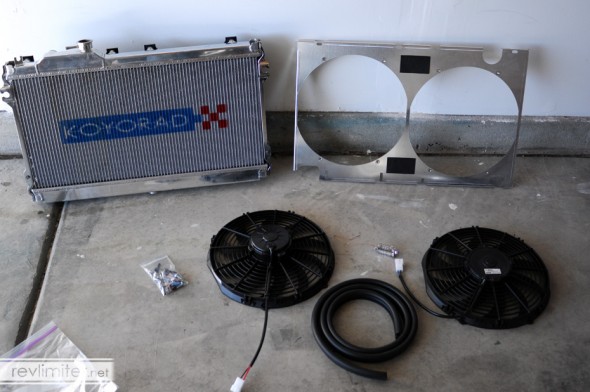
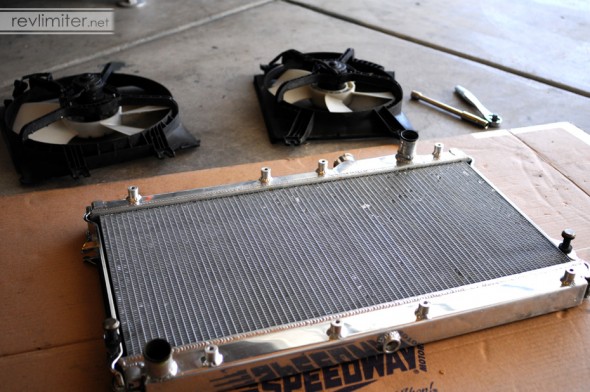
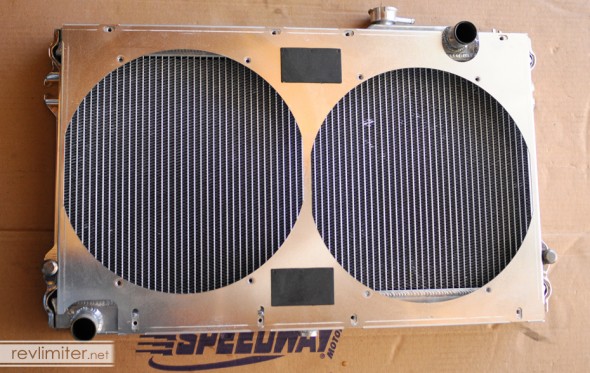
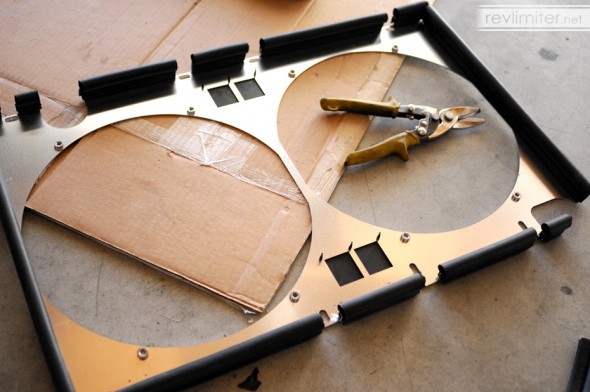
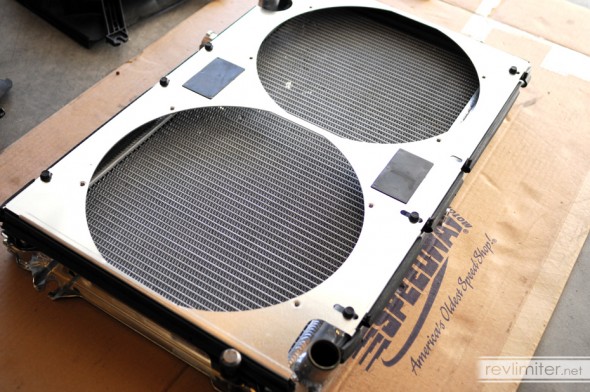
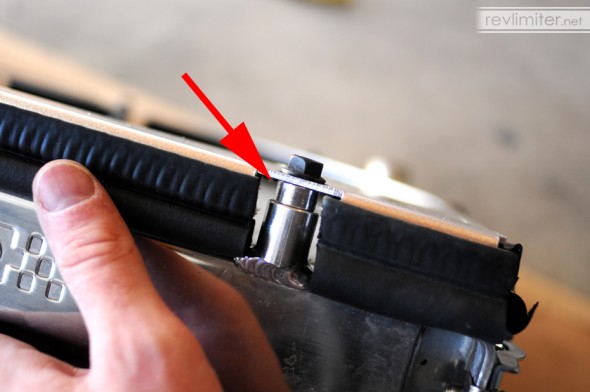
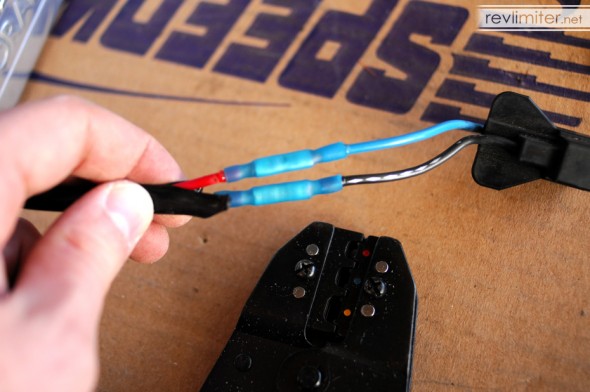
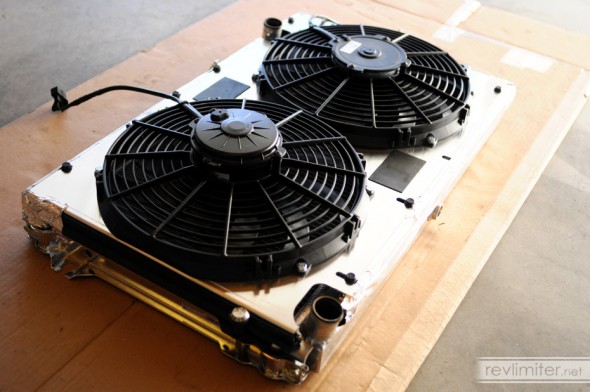
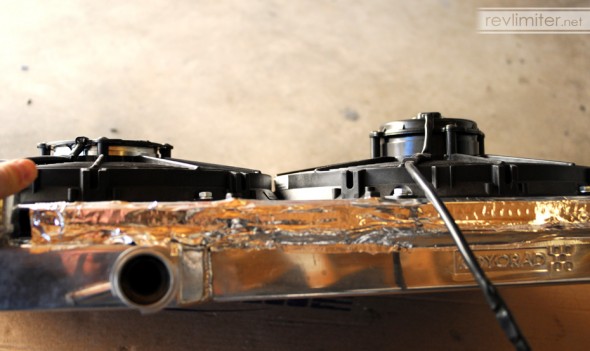
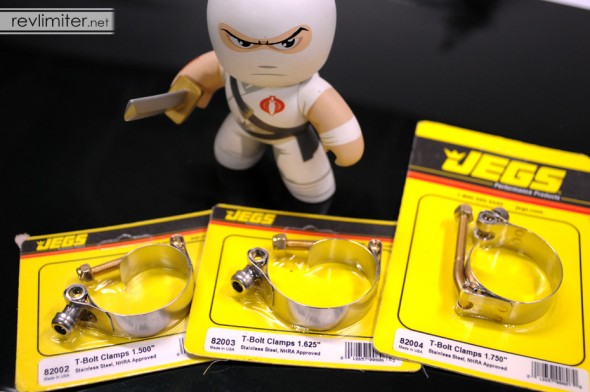
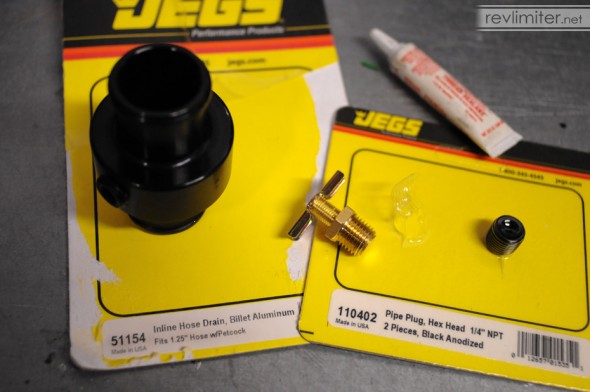
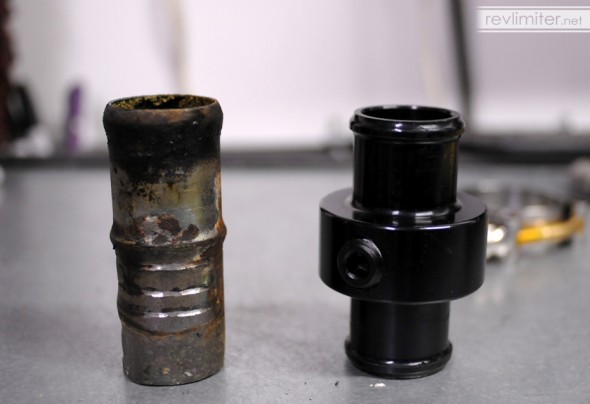


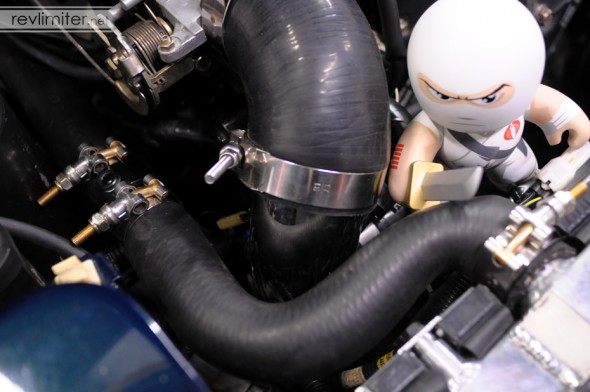
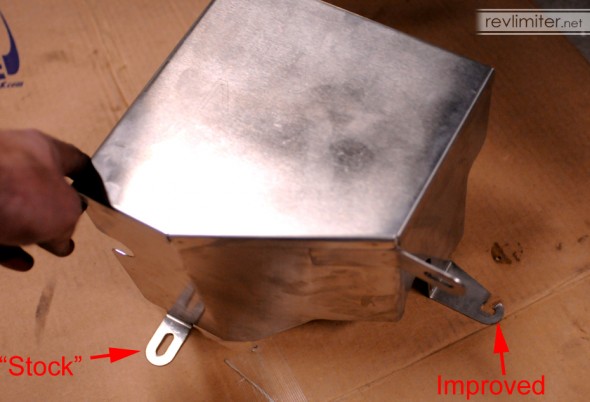
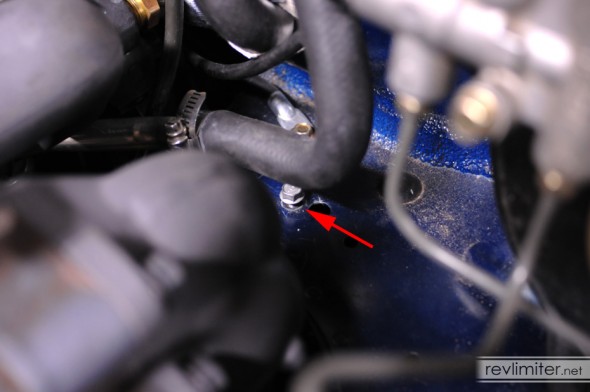
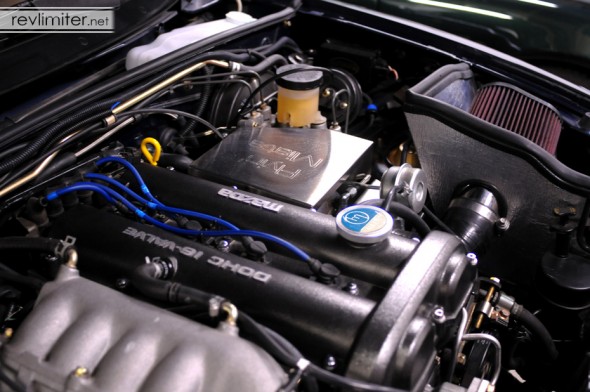
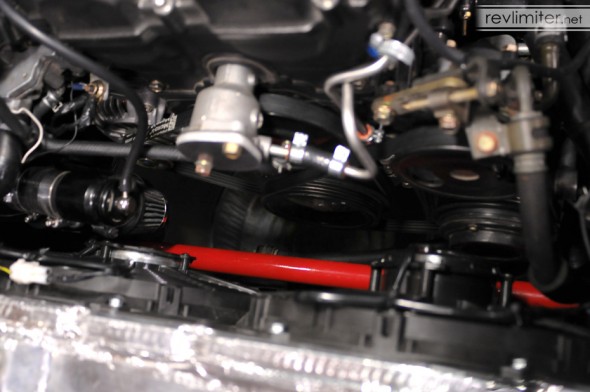

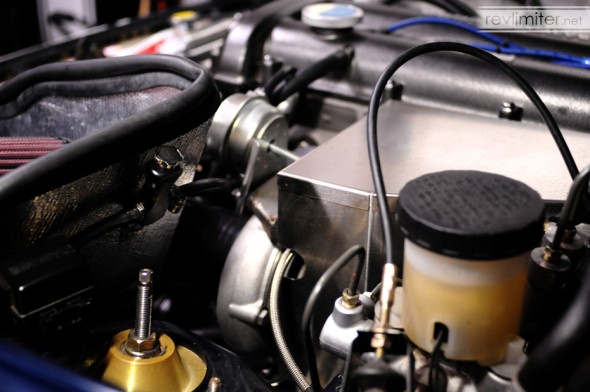
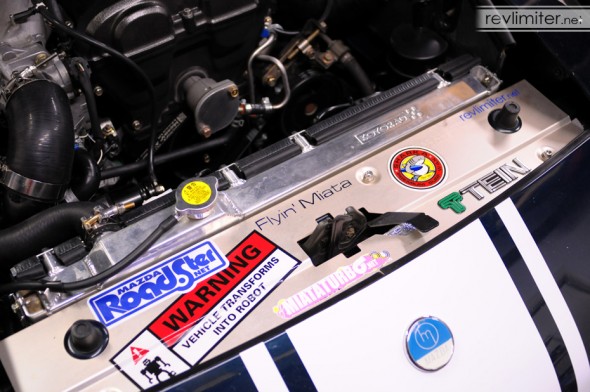
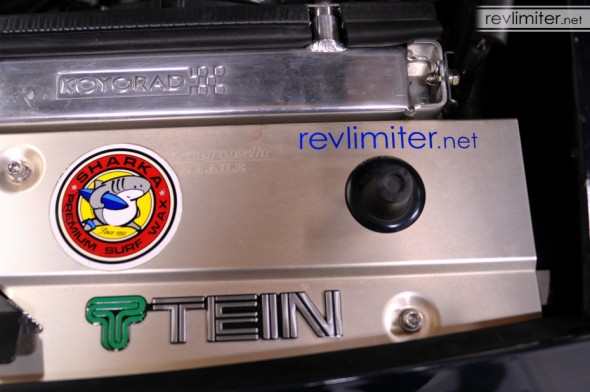




Where can I get a revlimiter.net sticker?!
I’ve been sending them out with every gauge order. I could, perhaps, see that you get one…
That does look like a very nice efan kit. I never really thought about the distance between the rad and fans but it makes perfect sense now.
I also agree with Dave where do I get one of those stickers?
AND sealing up the corners with something. That’s also key to making a fan kit efficient. If it can suck air from around the radiator rather than through it, it will. Air is lazy.
I need more stickers.
So, way to go on another great read and awesome install.
Hope it works well, if it does, might be worth my wile to do at the same time as a coolant reroute…
The endless possibilities of miatae…
FM suggests you remove the radiator to install the fans and shroud. And I agree. It was very easy. No wedging things in place or fighting with a/c hoses. If you’ve got your coolant system open, some fans would be an easy choice.
Adam, I’ve been looking at heat reflective tape for my FMII kit to keep things cooler. Try checking out some of the DEI stuff. I think you can get it in either gold or silver. It’s good to 500F continuous/2000F spikes. I’m guessing the adhesive will hold up much better than the aluminum-ized duct tape.
The DEI stuff looks great. I’d love to line my firewall in that gold foil. Not that I have a need at this time, I just love how it looks. heh
Thanks for the suggestion! I’d not thought about DEI’s heat barrier for this.
i too have the new fan kit.It is great and fixed my overheating problems in the HOT florida climate.I highly reccommend it to anyone in need of turbo cooling.
Heh. I think Arizona is just about the only state that can complain to New Mexico about heat. We were seeing 110s for about a month last summer.
nice writeup, are you able to get rid of that old thermostat neck all together with a freeze plug?
Sure! The only reason I kept the thermostat neck is due to my turbo water lines. I’ve got the nice FM hard line upgrade. One of them plugs into the hard line. I could have easily extended the throttle body water line to connect, but… well… I didn’t think of it at the time.
Yet another very useful post. Thanks. I just used this info and some from Part 2 to order parts to get my reroute working with my new FM CAI.
I had some engine work done a while ago at a shop I should not have chosen; now the wiring harness and plumbing are quite a mess. Can you suggest any resources for getting that all straightened out?
There are some wiring diagrams on Miataturbo. Check in the forum at the top (useful saved posts I think?) and there’s an obviously titled thread in there.
If you can’t find the diagrams you need, hit my contact form. I’ve got a bunch of PDFs saved. They’re just not something I feel right in publishing since they’re not my original content. I think they came from Yorba Linda Miata Club or something like that.
Cool. Thanks for the link.
Does this application go over the existing radiator or replace it?
Not sure I understand. The FM fans go in place of the stock fans.
Oh ok, its a replacement to the stock radiator i see. Sorry for the confusion.
. Adam,
As I am drooling over your engine compartment I see a nicely colored valve cover. Did you paint this yourself or have it powder coated.
Thank you for any info.
Lance
It’s powdercoated. Black and silver wrinkle finish. I had it done years and years ago. Maybe 8 years at this point.